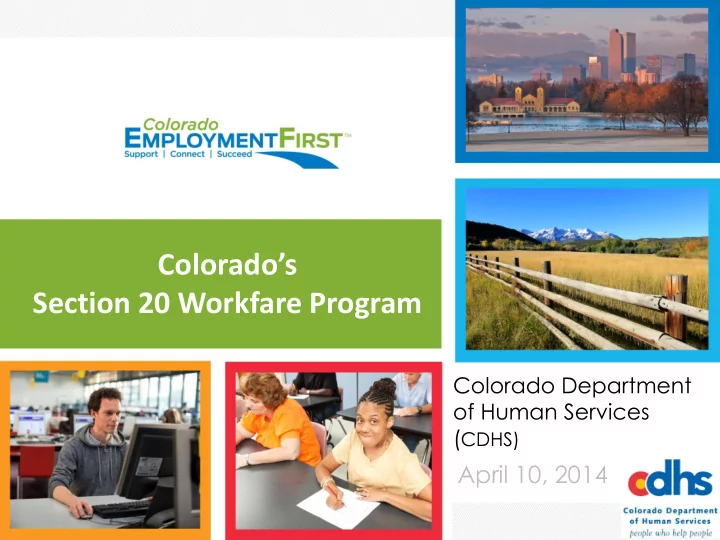

Colorado’s Section 20 Workfare Program Colorado Department of Human Services ( CDHS) April 10, 2014
SNAP and SNAP E&T in Colorado FFY 2013 • State Population 5,187,582 • SNAP recipients statewide 506,889 • Mandatory work registrants 93,407 (17% of total recipients) • Number of active SNAP E&T participants: 24,359 SNAP E&T • Operating continuously since 1983 • Called “Employment First” in Colorado • State Supervised and County administered • Currently in 27 out of 64 counties including 10 most populous •
Colorado Employment First FFY 2014 ________ Sedgwick Logan Larimer Weld Moffat Phillips Jackson Routt Morgan Grand Yuma Boulder Rio Blanco Adams Washington Gilpin Clear Denver Arapahoe Creek Eagle Garfield Summit Jefferson Elbert Kit Carson Douglas Pitkin Lake Park Mesa Teller Lincoln Delta Cheyenne El Paso Gunnison Chaffee Fremont Kiowa Montrose Crowley Ouray Pueblo Saguache Custer Hinsdale San Miguel Prowers Bent Otero San Dolores Huerfano Juan Mineral Alamosa Rio Grande Montezuma Las Animas Baca La Plata Costilla Conejos Archuleta County Workforce Training Department Goodwill Hilltop Non- E & T Social Center Advantage of Labor Services
Section 20 Workfare §273.22 , Title 7 Federal Regulations “ The primary goal of workfare is to improve employability and enable individuals to move into regular employment .”
Background 1992 - Colorado started Section 20 Workfare as a pilot in 1 county 1998 - Expanded to 7 counties 2002 - Mandatory for all counties with SNAP E&T (43 counties) 2013 – SNAP E&T with Section 20 Workfare in 27 counties Funding Colorado SNAP E&T Program expended $7.8 million in 2013 $2 million of that total was for Section 20 Workfare Colorado averages $1.5 million annually in enhanced funding
Section 20 Workfare Data – FFY 2013 • 30% of the 93,407 SNAP E&T population participated in Section 20 Workfare • 878,902 total hours worked at worksites • 4,850 jobs reported • $9.33 average wage • $1,767,237 earned in enhanced funding • 4,295 sanctions imposed
Section 20 Workfare Independent of the SNAP E&T program Separate Workfare State Plan submitted to FNS Can include TANF and UI recipients as mandatory participants Operated only by public or private nonprofit entity (e.g. county office, Department of Labor, Goodwill Industries)
Section 20 Workfare (cont. ) Involves tracking jobs and changes in allotment Specific requirements for documentation and record keeping FNS reimburses only 50 percent of agency’s administrative costs (100% federal funds cannot be used for this purpose) Earns Enhanced Funding
What is Enhanced Funding? • The share of the benefit reduction is three times the difference divided by two Formula: 1.5 x reduction or elimination of food assistance Example: $200 reduction x1.5 = $300 enhanced funding
Joining E & T and Section 20 Workfare Together Each serves the SNAP population Each has a goal of Employment Both support voluntary work as a strategy Both are FNS monitored through State Plans State and Counties front costs to build and maintain the program’s infrastructure Enhanced funding is an incentive to continue to invest in program operation
Starting a Section 20 Workfare Program • Worksites and required forms developed • Participants placed on worksites • Initial SNAP allotments recorded • Participation monitored monthly • When participant leaves Workfare, job info is recorded if start date within 30 days • SNAP benefits monitored to capture reduction • Enhanced Funding up to six months later
Required Workfare hours per month Entire household allotment = required State minimum wage hours Example: $200/$8.00* = 25 hours each month $367/$8.00* = 46 hours each month *Note: Colorado’s minimum wage is $8.00. The denominator must either be the federal minimum wage of $7.25 or the state’s minimum wage, which ever is the higher of the two .
Benefits for Participants Employment networking opportunities Gain experience, enhance current skills Current employer reference Involves individual in the community Employers prefer to hire those already working Work experience can make up for a lack of education
Agency Benefits Individuals in frequent contact with SNAP E&T are more likely to report changes affecting their SNAP case, including employment. Enhanced funding provides an incentive to operate an effective Workfare Program. Section 20 Workfare is an efficient way to serve high numbers of individuals
Community Benefits Individuals contribute to community services in exchange for the benefits they receive. Public and private nonprofit agencies benefit through numerous hours of volunteer time. Individuals on assistance move to employment more quickly.
Questions? Reggie Bicha, Executive Director Colorado Department of Human Services 303-866-3475 reggie.bicha@state.co.us Sue McGinn, Director Food and Energy Division Colorado Department of Human Services 303-866-2535 sue.mcginn@state.co.us Kathleen Mahoney, Manager Colorado Employment First Program Colorado Department of Human Services 303-866-2629 kathleen.mahoney@state.co.us
Recommend
More recommend